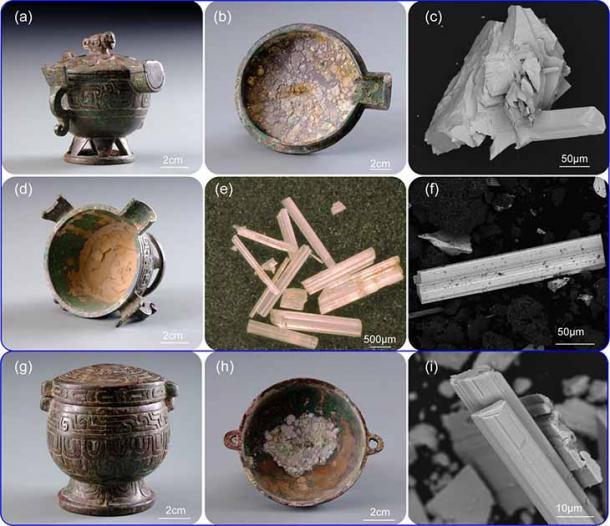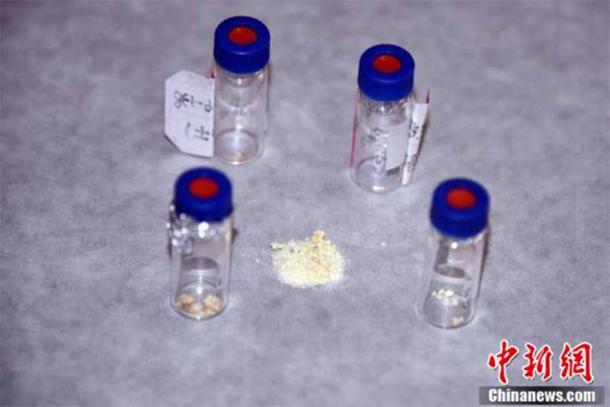The Chinese May have Been First to Use Synthetic Skin-whitening Cosmetics
A new study suggests that the Chinese may have been the first to use synthetic skin-whitening makeup and were making it before the Greeks and Romans. Bronze jars excavated from an elite tomb in Liangdaicun in northwest China’s Shanxi province were found to contain a white residue that on examination proved to be synthetic lead white makeup. The tomb dated to the early Spring and Autumn period (770 BC-476 BC).
Pre-dating the Roman Lead Products
It’s generally the Romans who’ve been ‘credited’ with the earliest use of lead for painting their faces white in around 500 BC. And the lead white synthesizing process had been discovered by the Greeks in the fourth century BC. However, when lead white first showed up in East Eurasia and whether it was used as a cosmetic aid hadn’t been much explored. The new study published in the Humanities and Social Sciences Communications journal examined the residue powder discovered in cosmetic jars in the Liangdaicun site tomb and concluded that it was the earliest synthesized lead white in the world to date. This suggests that the lead white synthesizing process had developed independently in East Eurasia and was being used for the manufacture of cosmetics.
- Savoring the Danger: Romans Loved Toxic 'Sugar of Lead' Wine
- Five things the ancient Greeks can teach us about medicine today

Residue from numerous containers were found to contain synthetic lead white . (Bin Han et al. / Nature)
The People’s Daily Online reports that the study co-authored by researchers from the University of the Chinese Academy of Sciences (UCAS) and the Shaanxi Academy of Archaeology proves that the Chinese were using synthetic lead white as a cosmetic 300 years before the Romans adopted the practice. According to the Daily Mail, the lead white residue was discovered in six bronze containers excavated from the tomb of an individual who lived 2,700 years ago and was buried in a cemetery for aristocrats.
Chemical Composition of Lead White and Chemical Synthesizing Process
Although the use of lead white naturally obtained through mining its carbonate, cerussite, goes back to between, the fifth and the second millennium BC in southern Europe, Egypt, Iran, Mesopotamia and the Indus Valley, its synthetic manufacture was seen in Europe only in the fourth century BC.
The authors of the study explain that the Greeks began employing a corrosion process for synthesizing lead white from the fourth century BC. This soon led to mass production and its widespread use in cosmetics and in art across Europe.
- Scientists Amazed to Discover 2,000-Year-Old Face Cream Still Containing Finger Imprints
- Poisonous Pigments: History’s Deadliest Colors

Samples of the residues of synthetic white lead cosmetics found in a bronzeware excavated from a tomb in Liangdai village, northwest China's Shaanxi Province. (China News Service/Sun Zifa)
However, their examination of the cosmetic residues from the tomb at the Liangdaicun site showed it to be the world’s oldest synthetic lead white. Further, it was synthesized using a precipitation in solution process rather than the corrosion technique employed by the Greeks. This points to an independent and earlier evolution of lead white synthetization in China, from around the first millennium BC.
The residue was found to contain pure cerussite, a mineral consisting of lead carbonate and an important ore of lead. Phosgenite, of lead chlorocarbonate, was also found, suggesting that the cosmetic was made by synthesizing the two.
According to the Daily Mail, the study team also pointed out that that the residue could be much older than the tomb. ‘Although the age of the lead carbonates does not fall exactly within the burial date of the tomb, it still reveals the synthetic origin of ancient samples because natural cerussite was observed to have a significantly larger offset.’
White Skin Came at a Cost
Lead white was the mineral most widely used in the manufacture of cosmetics, so much so that it triggered a cosmetic revolution and stimulated the development of chemistry in human history, according to the authors of the Humanities and Social Sciences Communications study.
However, this pursuit of beauty came at a cost. It caused skin damage and severe health issues to the users, sometimes even resulting in death. The Daily Mail cites a 2012 study that traces the downfall of Japanese feudal society to the stunting and deformity of Samurai children born to mothers who sported white lead makeup!
The downfall of the Roman Empire too has been attributed, at least in part, by several studies examining Roman skeletal remains to lead poisoning, admittedly ingested more through food, water and wine than makeup. A 2019 study, for example, found much higher levels of lead in Roman skeletons of ancient Londinium than those from Iron Age Britain. The levels were sufficiently high to cause negative health effects and possibly declining birth rates.
This did not prevent civilizations across the world from using lead white as a beauty aid until very recently. In ancient China, a white skin was a status marker and helped to establish aristocratic superiority over the lower classes. Ancient Chinese literature described a beautiful woman’s skin as akin to ‘snow’, ‘ice’ or ‘jade’. As a matter of fact, a white skin remains an obsession with the Chinese even today and skin-whitening products corner 30 per cent of the Chinese skin care market according to a study in the Economic Times.
Top Image: Chinese woman in white makeup, illustrative of how lead white makeup was once worn. Source: yuri2011 / Adobe Stock
By Sahir Pandey
References
Bin Han et al. 2022. Beauty and chemistry: the independent origins of synthetic lead white in east and west Eurasia. Available at: https://www.nature.com/articles/s41599-022-01290-6.
Liberatore, S. 2022. World's oldest skin lightening makeup - which was filled with LEAD - was used in China more than 2,700 years ago, 300 years before Romans adopted same technique. Available at: https://www.dailymail.co.uk/sciencetech/article-11185393/Worlds-oldest-skin-whitening-make-China-used-2-700-years-ago.html.
People’s Daily Online. 2022. World's earliest synthetic white lead cosmetics found in China's Shaanxi. Available at: http://en.people.cn/n3/2022/0906/c90000-10144110.html?fbclid=IwAR0Uu_mROdzr-b__jioqCWDIfMpft0h6u2eE0jJnq1y4j8B6sGk-Ge68ggY.
Scott, S.R. et al. 2019. Elevated lead exposure in Roman occupants of Londinium: New evidence from the archaeological record. Available at: https://onlinelibrary.wiley.com/doi/abs/10.1111/arcm.12513.
The Economic Times. 2011. Chinese consumers obsessed with white skin bring profits for cosmetics companies. Available at: https://economictimes.indiatimes.com/news/international/chinese-consumers-obsessed-with-white-skin-bring-profits-for-cosmetics-companies/articleshow/10796591.cms?from=mdr.


















Comments
Does the usage of this product in any way coincide with the incidence of smallpox and the scars it left behind? Queen Elizabeth I had smallpox and was left with scars on her face. She then started using this product to cover her face. I’m wondering how far back this effect might go? Google kindly states: The finding of smallpox-like rashes on Egyptian mummies suggests that smallpox has existed for at least 3,000 years. The earliest written description of a disease like smallpox appeared in China in the 4th century CE (Common Era).
It’s very likely women employed this product to cover facial imperfections and because lighter skin became appealing to men.
Anyone whos ever played eternal sonata XD
But the lesson here should be vanity is fatal
infinitesimal waveparticles comprise what we call home the earth
manipulatable by thought ability supressed in humans since birth
White pigment would have MANY USES. The question is, what was the reason they started applying it to faces?
Nobody gets paid to tell the truth.